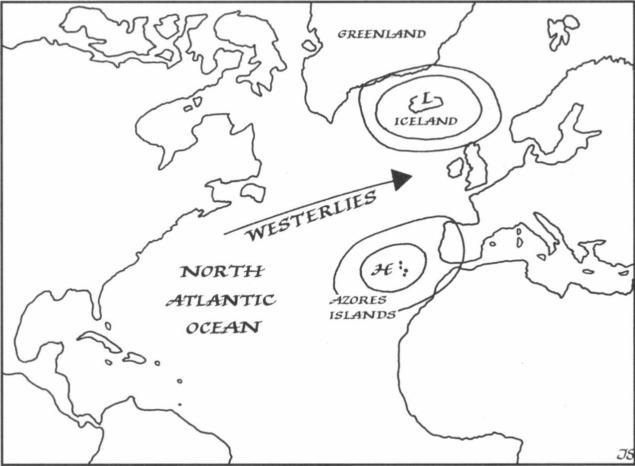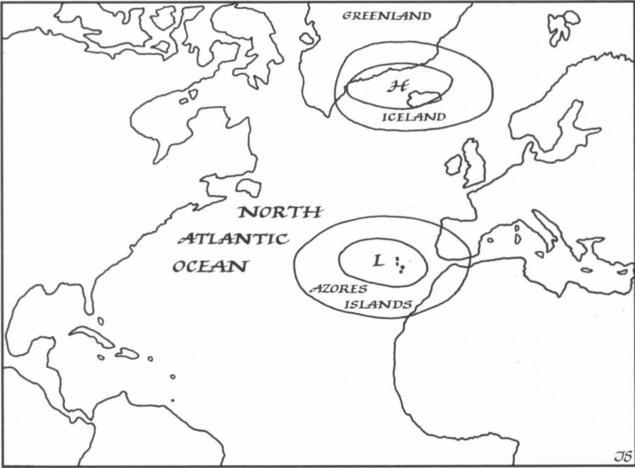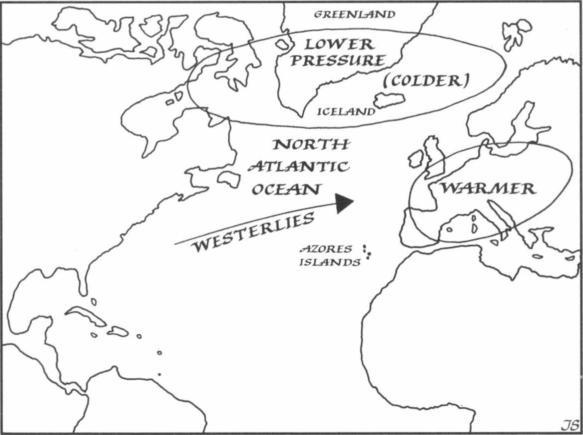The Little Ice Age: How Climate Made History 1300-1850 (7 page)
Read The Little Ice Age: How Climate Made History 1300-1850 Online
Authors: Brian Fagan

Every civilization expresses itself through its great works. They are society's most tangible statement of what is important enough to have scarce
resources lavished upon it. The Pyramids of Giza in Egypt were built at enormous expense as symbolic ladders to heaven for the divine pharaohs
who were buried in them 4,500 years ago. Aztec rulers of ancient Mexico
laid out their fifteenth-century capital, Tenochtitlan, "the Place of the
Prickly Pear Cactus," in the center of their vast empire as a depiction in
stone and stucco of their cosmos. Our industrial and commercial age
erects universities and museums, huge concert halls and stadiums, railroads, highways, and the World Wide Web. Medieval Europeans built
cathedrals. The cathedral was an act of piety, a wondrous monument, a
museum. Perhaps endowed with a sacred relic, a miraculous image, or a
sign of martyrdom, a cathedral at Canterbury, York or Chartres was a tangible symbol of the imminent presence of God. Even in good years, medieval Christians worried about harvests, the fertility of the land, the continuity of life itself. Cathedrals were the Bible of the illiterate poor, built
in an image of the cross and of the Body of Christ. Each represented a
corner of God's kingdom. They were expensive outpourings of love for
the Lord, sacrifices of stone and material goods offered in the expectation
of divine favor.
In 1195, Notre Dame de Chartres cathedral rose in northern France
on a sacred site occupied by six previous churches. Built in a mere quarter-century, Chartres is a masterpiece of Gothic architecture, where the
Christian cosmos becomes a miracle in stone and glass. The cathedral is
all windows, the great rose window of the western front symbolizing the
Virgin Mary herself, evoking soul, eternity, the sun and cosmos. The
other rose windows in the cathedral depict the Virgin and Child, the
martyrs who spread the Word and the New Testament, and the wounded
Christ at the center of the Last Judgment in the west window. Each window uses the same vocabulary of color, form, geometry and symbol. The
gemlike transmutation of the light shining through Chartres's windows
created transcendental effects that could heal and revivify the worshipers
crowded in the soaring nave. On the floor of the nave, a circular tiled
maze has a rose at the center, a labyrinth that depicts the path of the human soul through life on earth. There is only one maze path to the center.
The confusion of the maze walker reflects the complex journey of life on
earth, through the challenges of harvests good and bad, through war and
pestilence, through youth, adulthood, and old age.
Like other cathedrals, Chartres was a magnet of medieval life. Only
about 1,500 people lived in Chartres, except at major festivals, when as
many as 10,000 visitors crowded the cathedral. The great bells tolled in
times of joy and mourning. They sounded warnings and rang out with
exultation and in crisis. Every Easter, a New Light was kindled to celebrate the Resurrection and the new farming year. The faithful lit a thousand tapers and carried them from village to village, household to household, as life was renewed. Come autumn, hundreds of heavily laden carts
brought the fruits of a warm, bountiful summer as offerings to God. Like
the Norse conquests, cathedrals too are a consequence of a global climatic
phenomenon, an enduring legacy of the Medieval Warm Period.

For five centuries, Europe basked in warm, settled weather, with only the
occasional bitter winters, cool summers and memorable storms, like the
cold year of 1258 caused by a distant volcanic eruption that cooled the
atmosphere with its fine dust. Summer after summer passed with long,
dreamy days, golden sunlight, and bountiful harvests. Compared with
what was to follow, these centuries were a climatic golden age. Local food
shortages were not unknown, life expectancy in rural communities was
short, and the routine of backbreaking labor never ended. Nevertheless,
crop failures were sufficiently rare that peasant and lord alike might piously believe that God was smiling upon them.
Nothing prepared them for the catastrophe ahead. As they labored
through the warm summers of the thirteenth century, temperatures were
already cooling rapidly on the outer frontiers of the medieval world.
When the world was half a thousand years younger all events
had much sharper outlines than now. The distance between
sadness and joy, between good and bad fortune, seemed to be
much greater than for us.... There was less relief available for
misfortune and for sickness; they came in a more fearful and
more painful way. Sickness contrasted more strongly with
health. The cutting cold and the dreaded darkness of winter
were more concrete evils....
But one sound always rose above the clamor of busy life
and, no matter how much of a tintinnabulation, was never
confused with other noises, and for a moment, lifted everyone
into an ordered sphere: that of the bells. The bells acted in
daily life like concerned good spirits, who, with their familiar
voices, proclaimed sadness or joy, calm or unrest, assembly or
exhortation.
-Johan Huizinga
The Autumn of the Middle Ages
 omplex interactions between the atmosphere and the ocean govern
omplex interactions between the atmosphere and the ocean govern
Europe's climate. A constantly changing pressure gradient reigns over the
northern Atlantic and much of Europe's climate, its influence as pervasive
in the north as the celebrated Southern Oscillation of the southwestern
Pacific, which governs El Ninos and much tropical weather. The North
Atlantic Oscillation (NAO) is a seesaw of atmospheric pressure between a
persistent high over the Azores and an equally prevalent low over Iceland. This seems like an arcane piece of scientific information until you understand that the NAO governs the position and strength of the North Atlantic storm track and thus the rain that falls on Europe, especially during
winter.

High North Atlantic Oscillation index
The "NAO index" expresses the constant shifts in the oscillation from
year to year and decade to decade. A high NAO index signals low pressure
around Iceland and high pressure off Portugal and the Azores, a
condition that gives rise to persistent westerly winds. These westerlies bring
heat from the Atlantic's surface to the heart of Europe, together with powerful storms. The same winds keep winter temperatures mild, which makes
northern European farmers happy and produces dry conditions in southern
Europe. A low NAO index, in contrast, brings shallower pressure gradients,
weaker westerlies, and much colder temperatures over Europe. Cold air
from the north and east flows from the North Pole and Siberia, snow blankets Europe, and Alpine skiers have a wonderful time. NAO's winter oscillations account for about half the variability in winter temperatures in northern Europe and also exercise an important effect on summer rainfall.
A high NAO index brings more rain in the summer, as it did after 1314.

Low North Atlantic Oscillation index
The seesaw swings unceasingly, in cycles that can last seven years or
more, even decades, or sometimes much less. The swings are unpredictable and sudden. An extreme low NAO index causes a reversal of
winter temperatures between Europe and Greenland. When pressure in
Greenland is higher than in Europe-the "Greenland above" (GA) effect-persistent blocking high pressure systems form between Greenland
and Scandinavia. Temperatures are above average in western Greenland
and lower than usual in northwestern Europe (and also in eastern North
America). Winter in western Europe is bitterly cold. When pressure over
Greenland is lower than that in Europe-"Greenland below" (GB)then temperatures are reversed and the European winter is milder than
normal.
The extreme swings of the NAO are part of the complex atmospheric/ocean dynamics of the North Atlantic, which include sea-surface temperature anomalies, the strength of the Gulf Stream, atmospheric
wave structure, and the distribution of sea ice and icebergs. These interactions are poorly understood, but there seems little doubt that many of the
swings in the NAO result from changes in sea surface temperatures in the
North Atlantic. One day, computer simulations of dynamic ocean temperatures and atmospheric relationships may allow meteorologists to predict winter rainfall in Europe several years in advance, a scientific breakthrough of momentous importance.

Greenland below effect
